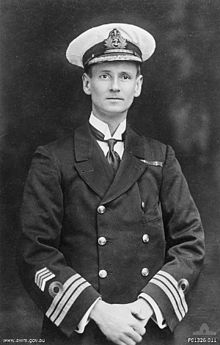Leighton Bracegirdle
| Sir Leighton Seymour Bracegirdle | |
|---|---|

Commander Leighton Bracegirdle c.1918
|
|
| Born | 31 May 1881 Balmain, New South Wales |
| Died | 23 March 1970 (aged 88) Sydney, New South Wales] |
| Allegiance | Australia |
| Service/branch | Royal Australian Navy |
| Years of service | 1898–1945 |
| Rank | Rear Admiral |
| Commands held | Royal Australian Navy Bridging Train |
| Battles/wars |
Boxer Rebellion Second Boer War First World War Second World War |
| Awards |
Knight Commander of the Royal Victorian Order Companion of the Order of St Michael and St George Distinguished Service Order Mentioned in Despatches (3) |
Rear Admiral Sir Leighton Seymour Bracegirdle KCVO, CMG, DSO (31 May 1881 – 23 March 1970) was an Australian military commander and an Official Secretary to four Australian governors-general: Sir Isaac Isaacs, Lord Gowrie, the Duke of Gloucester, and William McKell.
He was born in Balmain, Sydney, on 31 May 1881. He attended Sydney Boys High School, in 1898 he joined the New South Wales Naval Brigade as a cadet. Two years later he became a midshipman and served with the New South Wales contingent in China during the Boxer Rebellion.
Bracegirdle then served as a lieutenant in the South African Irregular Horse in the final year of the Boer War. He returned to Australia after being wounded and continued to serve in the naval militia while working as a clerk. He married Lillian Saunders in 1910 and in 1911 joined the Royal Australian Navy as a lieutenant, serving as District Officer in Newcastle until the beginning of the First World War.
In August 1914 Bracegirdle enlisted in the Australian Naval and Military Expeditionary Force, serving as a staff officer in German New Guinea until the force was disbanded in February 1915. That month he was appointed commander of the 1st Royal Australian Naval Bridging Train and was sent to Gallipoli to prepare for the British landings at Suvla Bay in August 1915. His unit performed well under relentless shrapnel fire and remained at Suvla, where Bracegirdle was wounded, until the end of the campaign. Having constructed the piers used during the British landing, the bridging train carried out maintenance duties; assisted with the landing of troops, stores, and ammunition; and finally assisted with the evacuation in December.
...
Wikipedia
